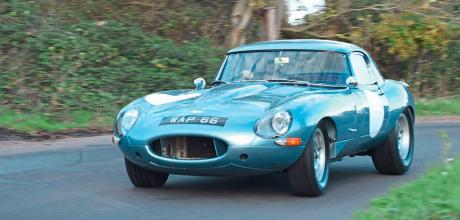1961 Jaguar E-Type Series-1 Lightweight Replica
Not only was this 1961 E-Type the first open-two-seater to feature factory seat belt mountings but it was later transformed into an evocation of the rare Lightweight model.
WORDS & PHOTOGRAPHY PAUL WALTON
LIGHTWEIGHT RARE E-TYPE RECREATION
E-TYPE Lightweight Replica
It may not be an exact replica of the famed lightweight racers, but this nicely finished creation comes very close.
Some are born great, some achieve greatness, and some have greatness thrust upon them,” wrote William Shakespeare in Twelfth Night. If the famous quote can also be applied to cars then it perfectly describes this 1961 E-Type open-two-seater. Not only is it a very early model that saw plenty of action on the track but it was later turned into a largely accurate copy of a rare Lightweight model.

If that doesn’t make it a great car with a great history, then I don’t know what does. Built on 13 December, 1961 and painted in Opalescent Dark Blue with a grey interior, chassis number 850301 was the first right-hand-drive open two-seater E-Type to feature factory-fitted seatbelt anchorage points. Sold via Henlys of London and despatched on 2 January, 1962, it was originally bought by Mr H A Pierpoint – father of future double British Saloon Car Champion, Roy Pierpoint – for his daughter, Patricia.
“These are some of the most valuable cars in the world”
Although Patricia has recently confirmed the car was part-exchanged at HMW Motors in Walton-in-Thames in the mid- Sixties, the next few years are a mystery. It’s said by some the E-Type was subsequently owned by two British racing drivers, Mick Jones from Surrey and later Fred Cliffe of Halifax, who both campaigned the car throughout the rest of the decade.
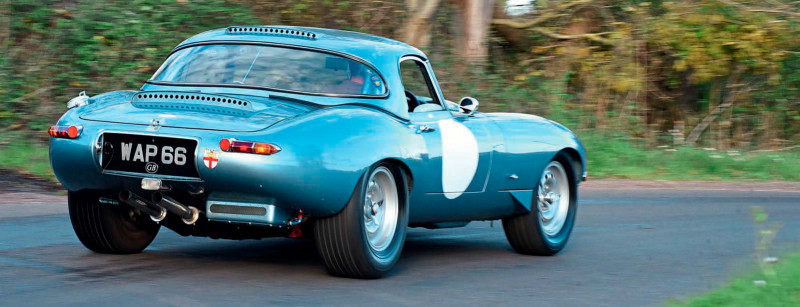
But this has been dismissed by others who reckon that was another car. What it is known for certain is that by the early Seventies 850301 was in the hands of another racing driver and well known E-Type specialist, Philip Bennett from Leeds in Yorkshire, who would race the car over the next three years. In 1973 he was involved in a serious accident at Longridge, a short circuit built in the former Tootle Heights quarry close to the Lancashire town of the same name, that left the car badly damaged.
Bennett kept 850301 in this state until the early Nineties when he rebuilt the E-Type, bringing it close to full Lightweight specification. Considered by many as the ultimate E-Type, for Jaguar enthusiasts the term ‘lightweight’ is as exciting as ‘lost Da Vinci’ is for art historians. Although the company pulled out of competition in 1956 and the E-Type was subsequently raced by private teams, Jaguar still needed to keep the car competitive, especially in the face of new stiff opposition such as the Ferrari 250.
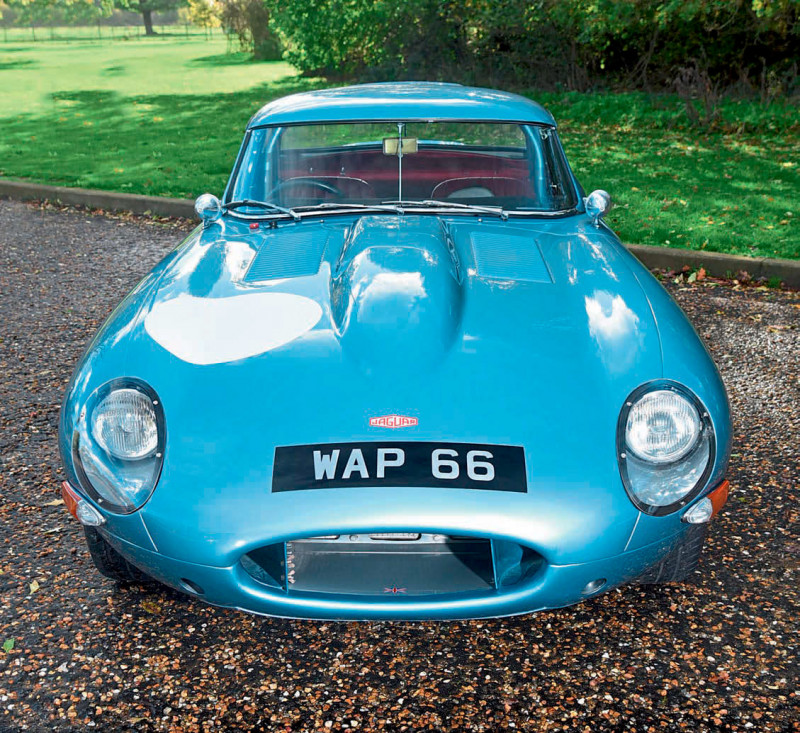
In early 1963, Jaguar developed a lightweight model inspired by 885006, an accident-damaged very early E-Type OTS which had been returned to the works and rebuilt with a thin gauge steel monocoque and aluminium bonnet, boot, doors and hardtop produced by local coachbuilder Abbey Panels. The panels were riveted together since the metal used couldn’t be spot welded and the resulting car achieved primary aim of lightness and at 960kg weighed around 113kg lighter than a steel car and 45kg less than the Ferrari.

The 3.8-litre XK unit had a new alloy block with fuel injection, something Jaguar had been working on with Lucas and SU since the early Fifties. Together with new suspension and brake parts plus several mechanical changes, it was a total reworking of the car and can be considered a model in its own right.
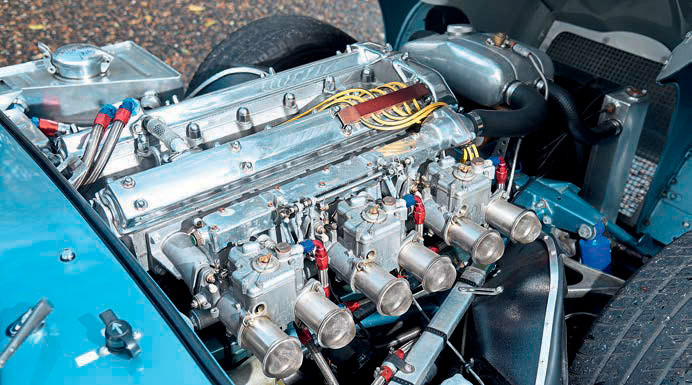
ABOVE: The 3.8 engine running triple Webers is reckoned to be good for 330bhp.
Following a second accident, this car was rebuilt again into the first lightweight aluminium monocoque — utilising most of the running gear and aluminium panels. This formed the basis of the specification of the next 11 lightweights to be built.
Yet despite being quick and ultimately successful, winning races and championships across the globe, only 12 of the planned 18 Lightweights were built, the other six finally produced by Jaguar Classic as part of its Continuation Programme in 2014. Their rarity and the fact that each example is unique in terms of both specification and history means these are some of the most valuable cars in the world. In 2017 chassis number S850667 – the tenth Lightweight made and arguably the most original – was sold at auction for $7,370,000 (almost £6m) making it the most expensive E-Type in the world.
It’s not surprising, then, that many standard models have been subsequently transformed into Lightweights, some with more accuracy and success than others.
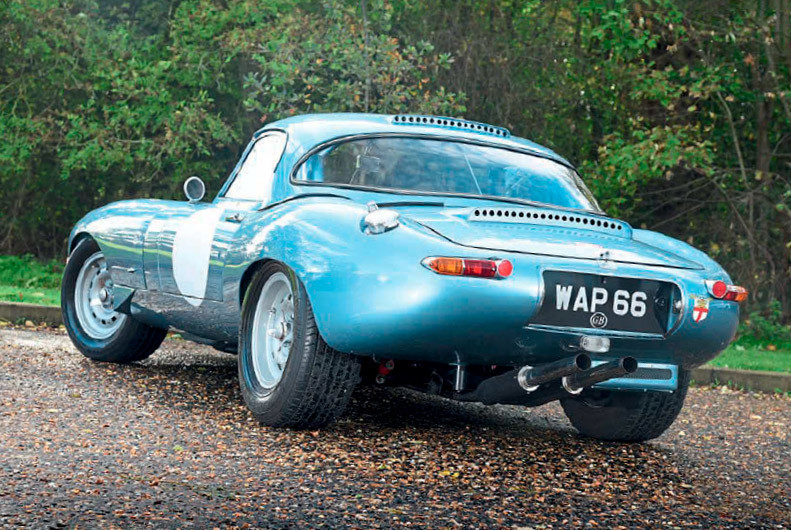
Wanting his recreation of a Lightweight based on 850301 to be correct, Bennett bought new aluminium panels from RS Williams. He even managed to source directly from Abbey Panels a genuine Lightweight bonnet from the original 1962 batch The 3.8-litre was uprated to racing spec with full D-Type dry sump specification, Piper cams, 45 DCOE Weber carburettors, Accralite pistons, 2in inlet valves and a fully gas-flowed head. The original Moss gearbox was then changed for a Getrag close-ratio five-speed box. The original cars were fitted with either a ZF unit, or a Jaguar four-speed unit.
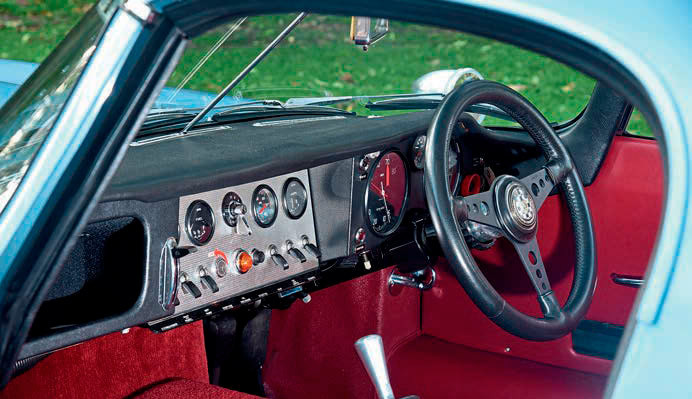
When it was finished, Bennet briefly raced the E-Type, the car’s competitiveness illustrated when he set the lap record of the Isle of Man’s 3.5-mile Willaston Circuit in 1993 before jointly winning Snetterton’s demanding Birkett Six Hour the same year. In 1994 the Lightweight E-Type was sold to Tony Statham who used it three times in the prestigious Rallye des Pyrénées. In 2006 and following another two UK-based owners, the car was bought by an American enthusiast. Once Stateside the car was regularly seen at classic car events, including the Quail Motorsports Gathering in Monterey, California, during the 2011 Pebble Beach Concours that celebrated the E-Type’s 50th anniversary.
The car is now back in the UK and currently for sale through marque specialists, JD Classics, which has invited me to its Chelmsford showroom for a drive of this magnificent machine. Having never driven a genuine Lightweight before but this example considered as close to one as a standard E-Type can get, I don’t need to be asked twice. The car looks resplendent in its metallic blue paint, the Dunlop-style alloy wheels from D Type Developments giving the car the correct purposeful stance of a true Lightweight. Together with the row of vents in the boot lid and roof, it could easily pass as one of the 12 originals. That changes when I open the door.

As pure competition machines, real Lightweights offer few creature comforts. As former racing driver, Tommy Sopwith – who had regularly driven the 11th Lightweight that was owned by his friend, Dick Wilkins – said in Philip Porter’s Jaguar E-Type The Definitive History, “Compared to some, it was a reasonably practical road car but there was no upholstery, no sound deadening. The fuel injection made as much noise as most road car exhausts, and of course it had the hardtop on it with no lining so that was fairly resonant. But it was a lot of fun.”
By comparison, with its seats upholstered by experts Suffolk and Turley in a rich red leather and the floors and gearbox tunnel covered in matching Wilton carpet, 850301 is positively luxurious. Only the four-point harness and bright red kill switch hint at what it’s capable of. Like all OTS E-Types fitted with a hardtop, the low roof, narrow door entry and wide sill make it tricky for me to climb inside and I need to twist my left leg in all manner of awkward angles to squeeze behind the Moto-Lita wheel. But once in place and the harness secured, it’s reasonably comfortable, my immediate view dominated by the large white-on-black 180mph Jaeger speedo and Smiths rev counter directly in front of me. I also notice the chrome bonnet latches are left in the out position, the long bonnet that stretches out ahead of me now secured by the older-style of exterior locks the genuine Lightweight bonnet was already fitted with. After hitting the starter button on the middle of the turned aluminium covering the central instrument panel, the 3.8-litre XK unit immediately bursts into life, the loud and distinctive bark revealing the car’s character perhaps more than its appearance.

ABOVE: The first Lightweight E-type was John Coombes’ 885006, seen here at Silverstone in 1963 with Graham Hill at the wheel.
With the stiff Getrag box having a dogleg first, I push the angled stubby lever down into first and after releasing the clutch, soon discover how easy it is to drive, lacking the trickiness and viciousness genuine racing cars can often have at low speeds. But when I reach the empty country roads that surround Chelmsford and put the hammer down for the first time, the car reveals its true colours. The 3.8-litre is said to be producing a minimum of 330bhp (that’s 65 more than standard), but with the aluminium-clothed car weighing much less than it would have done when new, the throttle pedal needs little encouragement for the acceleration to arrive so hard and fast it leaves me momentarily breathless.
As rev needle whizzes round to the other side of the dial, I pull the gear lever down into third and then up to fourth in quick succession, the engine always pulling strongly as I do so. Although the box is stiff, I learn that the more aggressive I amwith it, the cleaner the changes become. With practice, I’m soon snicking it down into third and balancing the throttle through a long bend before nailing it on the exit. Fitted with an exhaust by Tony Law, a UK-based specialist in handmade racing systems, whenever I squeeze the throttle, a deep, baritone growl fills the cramped cabin.

Bonnet is a genuine Lightweight part, sourced from the original 1963 production. Details like the boot vents and Dunlop- style wheels make this a convincing replica.
The steering is sharp and accurate and by not suffering from any vagueness like some lesser developed E-Types can, I can aim for a point in the road knowing I’ll get it spot on. The sticky Avon tyres are thankfully finding enough grip in the greasy autumnal conditions to keep me out of trouble and the car out of a ditch. Obviously the ride is uncomfortably hard but since Graham Hill, Roy Salvadori and all the other greats who raced a genuine Lightweight no doubt didn’t complain, neither will I. Plus, as my speed through tight corners starts to grow at the same time as my confidence, this firmness results in barely any hint of body roll.
But what strikes me most about the car isn’t its high speed or sharp handling but how easy it is to drive, even quickly, compared to the genuine racing machines I’ve driven in the past, including a pair of D-Types and a Ferrari 250 GT SWB. But with these being developed primarily for competition and this faux Lightweight starting life as standard road car, despite the many modifications, that side of its character hasn’t been totally dialled out. This leaves the car both devastatingly fast but also reasonably comfortable.
It’s this dual personality that more than being the first open example to have seatbelt anchors, what it later achieved on the track or the high levels of workmanship that’s gone into transforming it into a Lightweight that makes this E-Type genuinely great.
Thanks to: JD Classics (woodham-mortimer.com)


